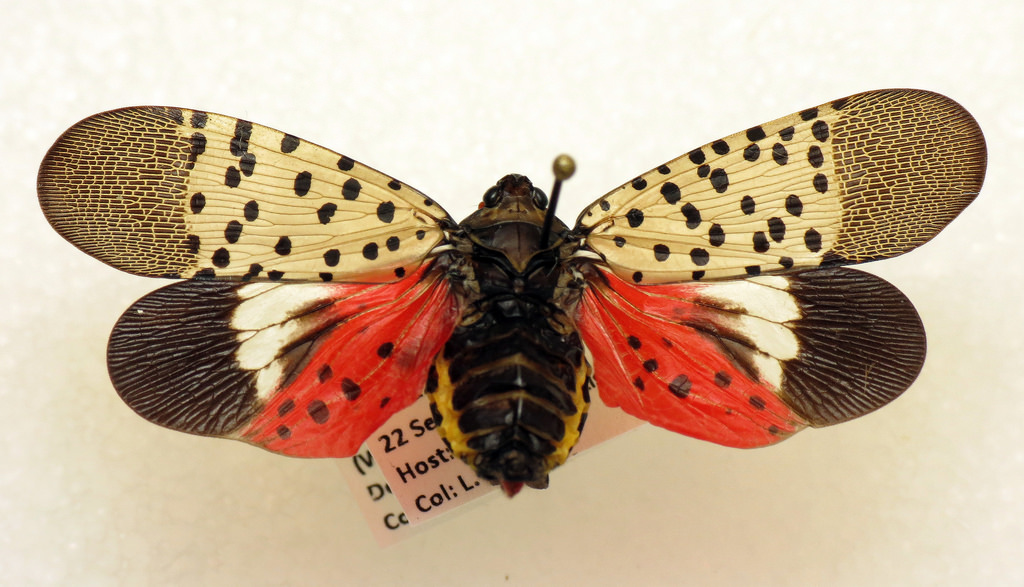Officials: Lanternflies pose threat to PA growers, timber industry
Forget about the gypsy moth, emerald ash borer and stink bug.
Pennsylvania has a new invasive insect species, and according to officials with Pennsylvania’s Department of Agriculture, it could be the worst one yet.
“The spotted lanternfly feeds on many types of plants, and the populations grow very quickly,” said Sven Spichiger, entomology program manager with the Pennsylvania Department of Agriculture. “It has been known to attack grapes, hops, basil, cucumbers, radishes and even forest trees like black walnut have started showing visual damage.”
That has local growers — such as Tom Webb, of Spyglass Ridge Winery — worried.
“As a grape grower, this is creating a lot of anxiety for me,” he admitted. “From what I’ve heard about the lanternflies from growers in the southeastern part of the state, you don’t just lose some fruit, or some of your canopy — you literally lose vineyards.”
Valley on alert
Lanternflies have become abundant in Berks, Bucks, Lehigh, Northampton, Montgomery and Chester counties, but Spichiger admits it may not be long until they potentially could have sightings throughout the Central Susquehanna Valley.
“Spots in the southeast part of the state that had just a few lanternflies last year are seeing several hundred thousand this year,” he said. “The chance of spreading is very high. It doesn’t take more than a few of them to infect an area. I fish every weekend in the Sunbury area, and while I haven’t seen any lanternflies myself yet, I wouldn’t be surprised if they’re out there.”
In an effort to stay ahead of the curve, scientists with the state’s department of agriculture have placed insect traps at Spyglass Ridge Winery, according to Webb, Shade Mountain Winery near Middleburg, according to owner Carl Zimmerman, and at other strategic places throughout the Valley.
Sticky situation
The lanternfly is a plant hopper, moving from plant to plant and piercing the stem or trunk of each as it goes, according to Spichiger. As it drills into a stem or trunk, it injects a sticky substance called honeydew as waste. That honeydew covers things in a sticky substance that causes a sugar mold that affects the plant and eventually puts off an unpleasant vinegar smell that draws in other insects.
“There are numerous concerns with the lanternfly, but perhaps the biggest involves the commodity crops, such as the timber industry,” Spichiger said. “The lanternflies lay eggs on timber, and as other states try to curb possible lanternfly infestations, they may attempt to quarantine lumber from our state. It could have a huge impact for many.”
There already is a general quarantine in Berks, Chester, Lehigh and Montgomery counties in an effort to keep the lanternfly and its egg masses from invading other parts of the state. Within those four counties, people are not allowed to move to another area any living life stage of the lanternfly, brush, debris, bark or other yard waste, landscaping, remodeling or construction waste, logs, stumps or tree trunks, firewood of any species, packing materials such as wooden crates, all plants and plant parts and outdoor household articles like RVs, lawn mowers, chairs, grills, tarps, tile and other similar items. Exceptions are made for those with proper permits or certificates.
Timber concerns
“We’re taking this seriously, and while I haven’t been working in that area, it could definitely cause a large problem for many, including those with vineyards and orchards,” said Dave Platt, a local forester. “People should be on the lookout for lanternflies and their signs. The lanternfly egg mass looks like a mud wasp nest to me — it is kind of camouflaged.”
Jon Geyer, with the state’s Hardwood Development Council, admitted that the lanternfly poses a huge threat to Pennsylvania’s timber industry.
“Pennsylvania leads the country in the amount of hardwood trees we produce — it’s more than a $20 billion industry for our state alone — so this threat could have serious effects,” he said. “Beyond grape plants and other species, we’ve seen the lanternfly attracted to maple trees due to their high sugar content and also to walnut trees, which produce a nice, dark wood that people really like.”
Chris Bingaman, with Bingaman & Son Lumber near Kreamer, admitted that those in the local lumber industry are familiar with invasive threats.
“We’ve had so many invasive species. What we went through with the emerald ash borer has been tough,” he said. “In the past, there was a huge threat from gypsy moths, but methods were found to reduce the damage. There is very little we can do to stop the ash borer, and the last thing we need is another invasive insect to worry about.”
Invasive attack
The lanternfly originated in southeast Asia and is not native to Pennsylvania. It is especially attracted to Tree of Heaven, an invasive plant species that has been spreading across the state and that is hard to kill without using herbacide. In southeastern counties, according to Spichiger, lanternfly eradication efforts include removing nearly all of the Tree of Heaven plants on a property — leaving just a few as a “trap” that are covered in insecticide that kill the lanternflies they attract.
Ultimately, the state’s department of agriculture needs help in detecting lanternfly populations early. If you find one, Spichiger requests that you immediately call the state’s lanternfly hotline (866-253-7189) or email your findings to badbug@pa.gov. If you can keep the sample for confirmation, Spichiger said it would be extremely helpful.

